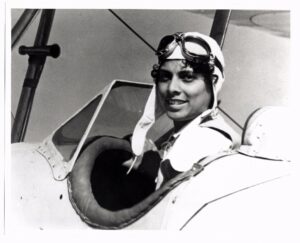In honor of the 40th anniversary of the Artist in Residence Program and Kentucky Women’s Suffrage Centennial in 2020, Bernheim presents FEMMEnomenal Bluegrass Botanicals by Gabriella Boros. This exhibition celebrates the extraordinary achievements of 10 Kentucky women through the invocation of 10 native Kentucky plants.
Meet Willa Beatrice Brown
Barren County, KY, 1906-1992

Willa Beatrice Brown challenged society with her great skill and determination at a time when Black women were treated harshly. After receiving a master’s degree from Northwestern University in 1937, she earned a private pilot’s license in 1938 and a commercial pilot’s in 1939, making her the first Black woman to be licensed to fly in the United States.
Brown was also the first Black American woman to become an officer in the Illinois Civil Air Patrol (CAP). While enrolled at Northwestern University, she joined the Challenger Air Pilots Association and learned to fly at Harlem Field, on the southwest side of Chicago. In 1935 she earned her Master Mechanic Certificate and began giving flight and ground school instruction at the field.
In 1936, she made a professional pitch to the Chicago Defender for publicity for a Black American air show to be held at Harlem Field. The advertising resulted in an attendance of between 200 and 300 people and showcased a number of talented Black pilots in the Chicago area.
Brown and her husband Cornelius Coffey organized CAP Squadron 613 in conjunction with his school, the Coffey School of Aeronautics, and she held the ranks of lieutenant and adjutant in the organization. She was the director of the Coffey School when it was selected by the Civil Aeronautics Administration as one of several Black schools and colleges to offer the Civilian Pilot Training Program (CPTP — a program that trained thousands of pilots throughout the United States). The success of the Coffey and other Black aviation students led to the eventual admission of Blacks into the Army Air Forces through the War Training Service Program (WTS) at these schools and provided a pool of instructors and trainees at Tuskegee Army Air Field.
After becoming the first Black officer in the Civil Air Patrol in 1941, Willa trained more than 2000 Black pilots, including many Tuskegee airmen. A lifelong advocate for gender and racial equality, she ran for US Congress three times and taught in the public school system until late in life.
 FEMMEnomenal Bluegrass Botanicals celebrates the collective value women have had on our history, and much like the native plants in Kentucky, despite all the challenges, are still here, standing tall and beautiful, each in their own way.
FEMMEnomenal Bluegrass Botanicals celebrates the collective value women have had on our history, and much like the native plants in Kentucky, despite all the challenges, are still here, standing tall and beautiful, each in their own way.
Willa is represented by the Shooting Star (Dodecatheon meadia), as she herself, went flying into the stratosphere with her achievements.
While in residence at Bernheim, Boros created a series of woodblock prints that celebrate ten notable Kentucky women. The prints, enlarged into fabric hangings, are suspended from trees along Lake Nevin Loop.
*Additional information for this post courtesy of the Barron Hilton Pioneers of Flight Gallery, National Air and Space Museum, Smithsonian Institution.

